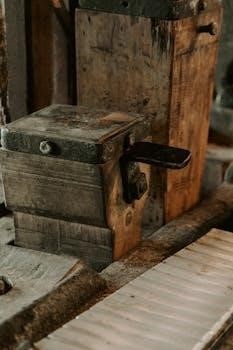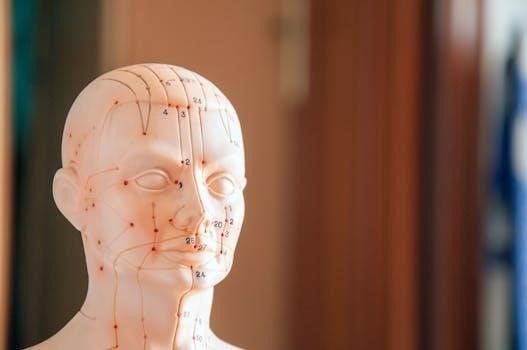Honeywell TH6220U2000 Installation Manual
This manual provides comprehensive instructions for installing the Honeywell TH6220U2000 thermostat. It covers package contents, UWP mounting, wiring for conventional and heat pump systems, thermostat mounting, system operation, installer setup, troubleshooting, and specifications, ensuring a smooth and efficient installation process. Refer to this guide for proper setup.
Package Contents
Before beginning the installation of your Honeywell TH6220U2000 thermostat, it’s crucial to verify that all necessary components are present in the package. The standard package includes the T6 Pro Thermostat itself, which serves as the primary control unit for your heating and cooling systems. You should also find the UWP Mounting System, designed for easy and secure attachment of the thermostat to the wall. An optional Decorative Cover Plate may be included, allowing you to conceal any paint gaps from the previous thermostat installation.
Furthermore, the package contains screws and anchors for mounting the UWP, ensuring a stable and reliable installation. Two AA batteries are provided to power the thermostat, although their use may depend on your system’s wiring configuration. Lastly, you will find the Installation Instructions and User Guide, which offer detailed steps and information for proper setup and operation. If any of these items are missing, contact Honeywell customer care for assistance.
UWP Mounting System Installation
Prior to commencing the UWP (Universal Wiring Plate) mounting system installation, ensure that the power to your heating and cooling system is turned off at the breaker box or switch to prevent any electrical hazards. Begin by opening the thermostat package to locate the UWP. Position the UWP on the wall at the desired location, ensuring it is level using a level tool. Mark the positions for the mounting holes with a pencil.
Next, drill holes at the marked positions, using a drill bit size appropriate for the provided wall anchors. Lightly tap the supplied wall anchors into the drilled holes, ensuring they are flush with the wall surface. Secure the UWP to the wall using the supplied screws, being careful not to overtighten them. The UWP should be firmly attached to the wall, providing a stable base for the thermostat. Ensure the UWP door is easily accessible for wiring.
Wiring Terminal Designations
Understanding the wiring terminal designations is crucial for proper installation. The “R” terminal is for 24VAC power. The “Rc” terminal is for 24VAC power (cooling transformer). In systems with one transformer, a slider tab connects “R” and “Rc.” The “C” terminal is for the 24VAC common wire. The “Y” terminal controls the compressor contactor in cooling systems. The “W” terminal is for the heating system. “G” connects to the fan relay, and “O/B” controls the reversing valve in heat pump systems (energize on cool or heat).
The “Aux” terminal is used for auxiliary heat. Ensure wires are correctly inserted into their designated terminals. Incorrect wiring can damage the system or thermostat. Always double-check wiring against the system’s wiring diagram. Depress the terminal tabs to securely insert or remove wires; Consult the system’s documentation for compatibility.
Wiring Conventional Systems
When wiring conventional systems, it’s crucial to differentiate between 1-transformer and 2-transformer setups. In a 1-transformer system, ensure the “R” and “Rc” terminals are connected via a slider tab. Connect the heating wire to the “W” terminal and the cooling wire to the “Y” terminal. The common wire goes to the “C” terminal. Connect the fan wire to the “G” terminal. For a 2-transformer system, keep “R” and “Rc” separate, each connected to its respective transformer’s power output.
The remaining connections follow the same pattern as the 1-transformer setup. Always turn off the power at the breaker before wiring. Confirm wire compatibility and follow the system’s wiring diagram. Incorrect wiring can cause damage. Use appropriate wire gauge and secure connections. Hydronic systems also follow this basic wiring, adapting to the specific zone valve or circulator wiring.
Wiring Heat Pump Systems
For heat pump systems, wiring configurations differ based on the system type. In a typical 1-stage heat pump system, connect the power wire to the “R” terminal, ensuring the “R” and “Rc” terminals are joined by a slider tab. The compressor contactor wire connects to the “Y” terminal, and the reversing valve wire (if present) connects to the “O/B” terminal. The common wire goes to the “C” terminal.
For multi-stage heat pump systems (specific to models like the TH6320U), additional wiring is required for auxiliary heat stages. Always refer to the specific wiring diagram for your heat pump model. Ensure all connections are secure and wires are properly insulated. Incorrect wiring can lead to inefficient operation or damage to the system. Remember to turn off power before any wiring changes.

Thermostat Mounting
Proper thermostat mounting is crucial. First, push excess wire into the wall. Close the UWP door securely. Align the thermostat with the UWP and gently push until it snaps in place. Finally, restore power at the breaker or switch.
Push Excess Wire
After completing the wiring connections to the UWP (Universal Wiring Platform) of your Honeywell TH6220U2000 thermostat, the next crucial step is to manage the excess wiring; Carefully and neatly push any extra wire length back into the wall opening. This step is essential for ensuring a clean and professional installation and prevents the wires from interfering with the thermostat’s proper seating and operation.
Avoid creating large bundles or kinks in the wiring, as this can make it difficult to close the UWP door and can potentially damage the wires over time. Distribute the wires evenly within the wall cavity, making sure they are not pressing against any sharp edges or components that could cause wear or damage.
Take your time to ensure the wires are properly tucked away, allowing the UWP door to close without bulging or resistance. A properly managed wire setup not only improves the aesthetics of the installation but also enhances the longevity and reliability of your thermostat system.
This seemingly simple step is a key element in achieving a successful and long-lasting thermostat installation.
Close the UWP Door
Following the proper management of excess wiring, the next critical step in installing the Honeywell TH6220U2000 thermostat is to close the UWP (Universal Wiring Platform) door. Ensure that all wires are neatly tucked away inside the wall cavity, allowing the UWP door to close completely and securely.
The UWP door should close without any bulging or resistance, indicating that the wires are not obstructing the mechanism. If you encounter difficulty closing the door, re-evaluate the wire arrangement and ensure that no wires are pinched or excessively bunched together. Re-adjust the wires as necessary until the door closes smoothly and stays firmly in place.
A properly closed UWP door protects the wiring connections from dust, debris, and potential damage, contributing to the long-term reliability and performance of your thermostat system. It also provides a clean and professional appearance to the installation.
Double-check the door’s closure before proceeding to the next step to guarantee a secure and functional setup. This seemingly small detail is essential for a successful thermostat installation.

System Operation Settings
To configure the Honeywell TH6220U2000, use the Mode button to select your desired system setting (Heat, Cool, Off). Cycle through the options until the preferred mode is displayed and let it activate. Note that available modes vary by model.
Setting System Mode
To effectively operate your Honeywell TH6220U2000 thermostat, understanding how to set the system mode is crucial. The system mode dictates whether your thermostat is actively heating, cooling, or set to an off state. To adjust the system mode, locate the “Mode” button on your thermostat’s interface. Pressing this button will cycle through the available options.
Continue pressing the Mode button until your desired system mode is displayed on the screen. The available system modes typically include “Heat,” “Cool,” and “Off.” The “Heat” mode activates the heating system to maintain a set temperature, while the “Cool” mode activates the cooling system. The “Off” mode deactivates both heating and cooling.
Once your desired mode appears, simply leave the thermostat, and it will automatically activate that mode. Keep in mind that the precise modes available may vary depending on your specific model. The settings can be adjusted for optimal performance and energy efficiency.

Installer Setup (ISU)
The Installer Setup (ISU) menu on the Honeywell TH6220U2000 thermostat allows advanced configuration options to tailor the thermostat’s operation to your specific heating and cooling system. To access the ISU menu, simultaneously press and hold the “CENTER” button and the “+” button for approximately three seconds. This action will bring you to the advanced menu, where you can fine-tune various settings.
Once in the advanced menu, press the “Select” button to enter the ISU settings. Navigating through the different ISU options is also achieved using the “Select” button. Each press will cycle you through available settings, such as heat stages, fan control, and compressor protection.
To modify the value of a setting or choose from available options, use the “+” or “-” buttons. After making your desired changes, press “Select” again to move to the next setting. Understanding and correctly configuring the ISU settings is vital for optimal thermostat performance and energy efficiency.

Troubleshooting
If you encounter issues with your Honeywell TH6220U2000 thermostat, several troubleshooting steps can help resolve common problems. Begin by checking the circuit breaker to ensure it hasn’t tripped. Reset the breaker if necessary. Also, verify that the power switch for your heating and cooling system is turned on.
If the thermostat display is blank, try replacing the AA batteries. Ensure they are correctly installed. For inaccurate temperature readings, make sure the thermostat is not exposed to direct sunlight or drafts. Relocate the thermostat if needed.
If the heating or cooling system isn’t responding to thermostat changes, double-check the wiring connections. Loose or incorrect wiring can cause malfunctions. Refer to the wiring diagrams in the installation manual. If the problem persists after these checks, contact a qualified technician for assistance to avoid potential damage or safety risks.